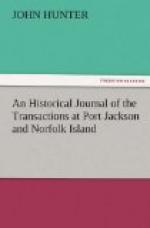Though Bannelong probably might be glad that Governor Phillip was not killed, yet there is not doubt but that the natives throw their spears, and take a life in their quarrels, which are very frequent, as readily as the lower class of people in England strip to box, and think as little of the consequences.
Mau-go-ran, the father of the native girl who lived with the clergyman, bad a bad wound on the back of his head, which he told the surgeon who dressed it, was done by a spear: it seems a dispute had taken place amongst these people, about sharing the whale, in which several lives were lost, and this man got his wound; and on the girl naming to her father a youth at -Kay-yee-my_, who she said would marry her, he told her not to go there, for they had quarrelled, and would throw spears, and that they would also throw spears at any white man; indeed, if this man’s information could be depended on, the natives were very angry at so many people being sent to Rose-hill; certain it is, that wherever our colonists fix themselves, the natives are obliged to leave that part of the country.
The weather being now very dry, the natives were employed in burning the grass on the north shore opposite to Sydney, in order to catch rats and other animals, whilst the women were employed in fishing: this is their constant practice in dry weather.
Though Bannelong did not pay Governor Phillip a visit, as he had promised, he readily joined those he saw in different parts of the harbour, notwithstanding they were armed, and went in his canoe to the longboat, though he saw several musquets in her: his wife was along with him in the canoe, and he gave those in the boat to understand that he would pay the governor a visit; probably the fear of being detained had hitherto prevented him, but whilst there was the least chance of his coming voluntarily, Governor Phillip was not willing to take him a second time by force, as it was likely he would soon be reconciled to pass a considerable part of his time at Sydnev, when he found he could be his own master, and go and come when he pleased.
On the 19th, Governor Phillip went to Rose-hill and returned to Sydney in the evening. The corn looked better than could be expected; but, the earth was so parched up by the dry weather that they could not get the remainder of their Indian corn into the ground until some rain fell. The weather for the last fortnight had frequently been cloudy and unsettled, and some light showers of rain had fallen at different times, but very little compared to what the ground required, or what might have been expected at this season. In the night of the 24th it began to rain, and some smart showers fell the next day, which enabled them to sow the remainder of their Indian corn; it was also of great service to the wheat and the vegetables in the gardens.
The column intended as a mark for the entrance of the harbour was now finished; it stands (as has already been observed,) on a cliff, a cable’s length from the south-head: it is a brick column on a stone base, and rises to the height of thirty feet.




